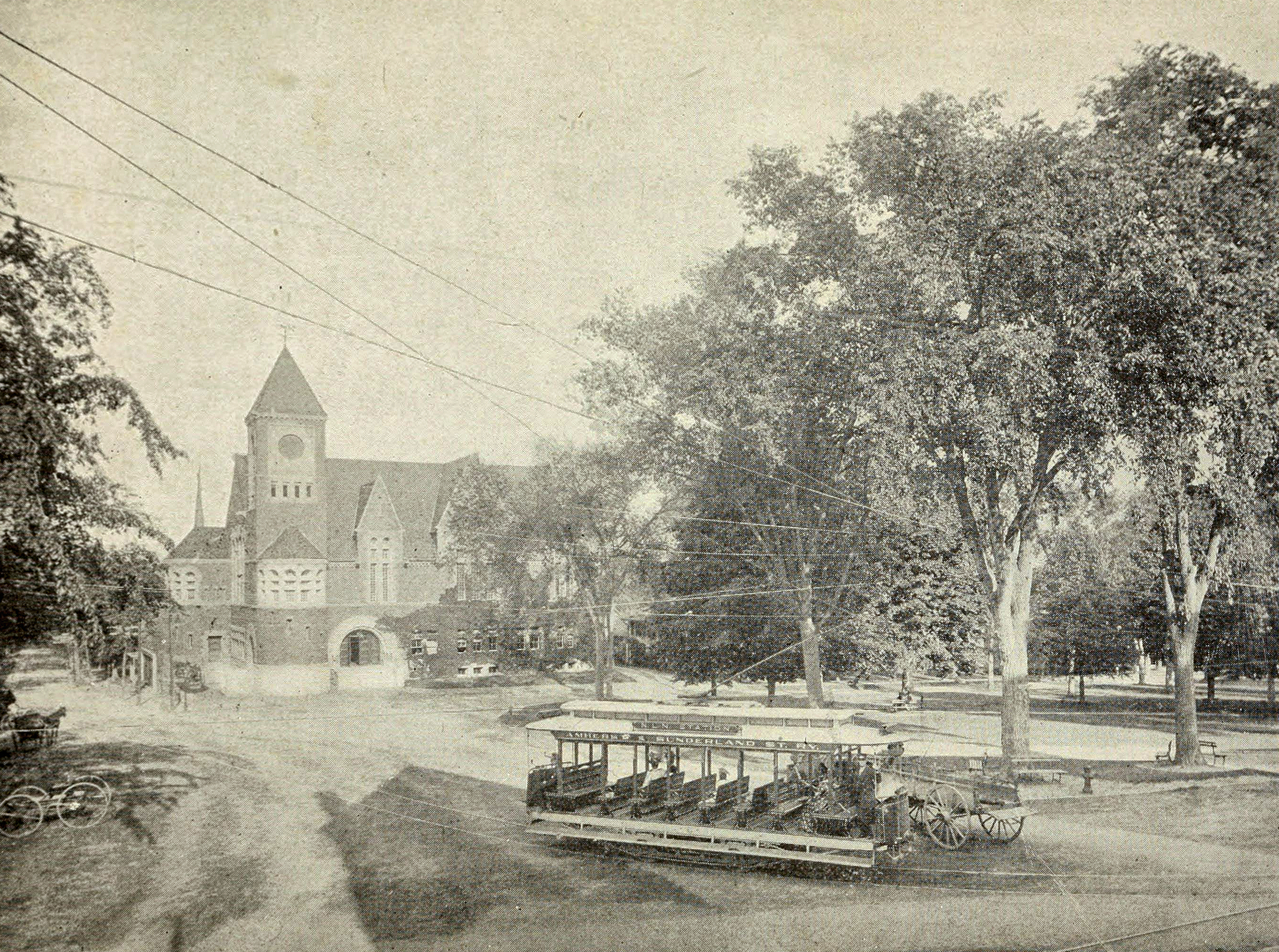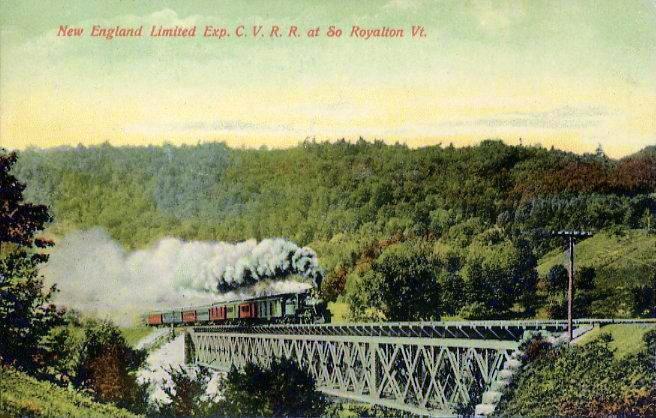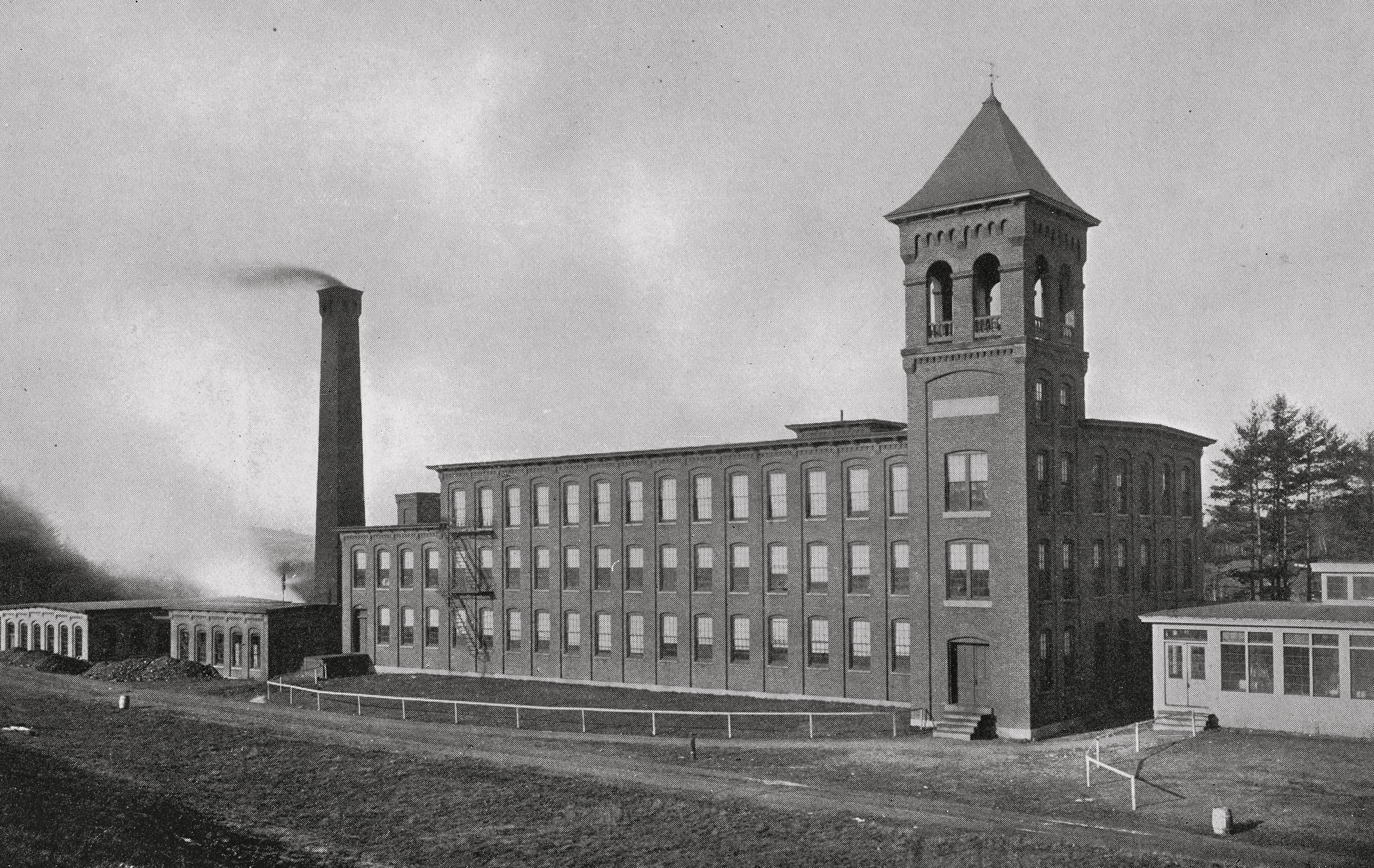|
New London, Willimantic And Palmer Railroad
The New London Northern Railroad was a part of the Central Vermont Railway from New London, Connecticut, north to Brattleboro, Vermont. After a long period with the Canadian National Railway, it is now operated by the New England Central Railroad. The New London Northern was the only through railroad in Connecticut not to come under the control of the New York, New Haven and Hartford Railroad. History The New London, Willimantic and Springfield Railroad was chartered in May 1847 to build from New London on the Long Island Sound north through Willimantic to Springfield, Massachusetts. On April 10, 1848, the name was changed to the New London, Willimantic and Palmer Railroad with the shift of the north terminus to Palmer. The first section, from Norwich north to Willimantic, opened in September 1849, and the part from Norwich south to New London opened the next month. The part north to Stafford opened in March 1850, and the rest of the way to Palmer opened in September of tha ... [...More Info...] [...Related Items...] OR: [Wikipedia] [Google] [Baidu] |
New London, Connecticut
New London is a seaport city and a port of entry on the northeast coast of the United States, located at the mouth of the Thames River in New London County, Connecticut. It was one of the world's three busiest whaling ports for several decades beginning in the early 19th century, along with Nantucket and New Bedford, Massachusetts. The wealth that whaling brought into the city furnished the capital to fund much of the city's present architecture. The city subsequently became home to other shipping and manufacturing industries, but it has gradually lost most of its industrial heart. New London is home to the United States Coast Guard Academy, Connecticut College, Mitchell College, and The Williams School. The Coast Guard Station New London and New London Harbor is home port to the Coast Guard Cutter ''Coho'' and the Coast Guard's tall ship ''Eagle''. The city had a population of 27,367 at the 2020 census. The Norwich–New London metropolitan area includes 21 towns and 274,055 ... [...More Info...] [...Related Items...] OR: [Wikipedia] [Google] [Baidu] |
Amherst, Massachusetts
Amherst () is a New England town, town in Hampshire County, Massachusetts, United States, in the Connecticut River valley. As of the 2020 census, the population was 39,263, making it the highest populated municipality in Hampshire County (although the county seat is Northampton, Massachusetts, Northampton). The town is home to Amherst College, Hampshire College, and the University of Massachusetts Amherst, three of the Five College Consortium, Five Colleges. The name of the town is pronounced without the ''h'' ("AM-erst") by natives and long-time residents, giving rise to the local saying, "only the 'h' is silent", in reference both to the pronunciation and to the town's politically active populace. Amherst has three census-designated places: Amherst Center, Massachusetts, Amherst Center, North Amherst, Massachusetts, North Amherst, and South Amherst, Massachusetts, South Amherst. Amherst is part of the Springfield, Massachusetts Springfield metropolitan area, Massachusetts, Metr ... [...More Info...] [...Related Items...] OR: [Wikipedia] [Google] [Baidu] |
Grand Trunk Railway
The Grand Trunk Railway (; french: Grand Tronc) was a railway system that operated in the Canadian provinces of Quebec and Ontario and in the American states of Connecticut, Maine, Michigan, Massachusetts, New Hampshire, and Vermont. The railway was operated from headquarters in Montreal, Quebec, with corporate headquarters in London, United Kingdom (4 Warwick House Street). It cost an estimated $160 million to build. The Grand Trunk, its subsidiaries, and the Canadian Government Railways were precursors of today's Canadian National Railway. GTR's main line ran from Portland, Maine to Montreal, and then from Montreal to Sarnia, Ontario, where it joined its western subsidiary. The GTR had four important subsidiaries during its lifetime: * Grand Trunk Eastern which operated in Quebec, Vermont, New Hampshire and Maine. *Central Vermont Railway which operated in Quebec, Vermont, Massachusetts, and Connecticut. *Grand Trunk Pacific Railway which operated in Northwestern Ontario ... [...More Info...] [...Related Items...] OR: [Wikipedia] [Google] [Baidu] |
Whitehall (village), New York
Whitehall is a village located in the town of Whitehall in Washington County, New York, United States. It is part of the Glens Falls Metropolitan Statistical Area. The village population was 2,614 in 2010. The village of Whitehall is located just south of the point where the Vermont border connects to the southern end of Lake Champlain. History The village was founded in 1759 as "Skenesborough" by Major Philip Skene, who built the barracks at Crown Point under Gen. Jeffrey Amherst. He sold out his commission in the British army to establish the community and the many associated enterprises he planned and later carried out. It was the first settlement at Lake Champlain and became an important trade center. It was on one of two routes between English and French colonies. On May 9, 1775, Lieutenant Samuel Herrick, leading as an advance party for Benedict Arnold's and Ethan Allen's attack on Fort Ticonderoga, surprised Major Skene and his small garrison. While he intended to use S ... [...More Info...] [...Related Items...] OR: [Wikipedia] [Google] [Baidu] |
South Londonderry, Vermont
South Londonderry is an unincorporated village and census-designated place (CDP) in the town of Londonderry, Windham County, Vermont, United States. As of the 2020 census, it had a population of 147. The center of the village comprises the South Londonderry Village Historic District. The CDP is in northwestern Windham County, in the south-central part of the town of Londonderry. It sits on both sides of the West River, a southeast-flowing tributary of the Connecticut River. Vermont Route 100 passes through the community, leading north to Londonderry village and south to Jamaica Jamaica (; ) is an island country situated in the Caribbean Sea. Spanning in area, it is the third-largest island of the Greater Antilles and the Caribbean (after Cuba and Hispaniola). Jamaica lies about south of Cuba, and west of His .... References Populated places in Windham County, Vermont Census-designated places in Windham County, Vermont Census-designated places in Verm ... [...More Info...] [...Related Items...] OR: [Wikipedia] [Google] [Baidu] |
Brattleboro And Whitehall Railroad
The Central Vermont Railway was a railroad that operated in the U.S. states of Connecticut, Massachusetts, New Hampshire, New York, and Vermont, as well as the Canadian province of Quebec. It connected Montreal, Quebec, with New London, Connecticut, using a route along the shores of Lake Champlain, through the Green Mountains and along the Connecticut River valley, as well as Montreal to Boston, Massachusetts, through a connection with the Boston and Maine Railroad at White River Junction, Vermont. History The Vermont Central Railroad was chartered October 31, 1843, to build a line across the center of Vermont, running from Burlington on Lake Champlain east to Montpelier, and then southeast and south to Windsor on the Connecticut River. Initial plans had the main line running through Montpelier. However, due to the difficulty of building through the Williamstown Gulf, a narrow valley south of Barre, Vermont, and to land interests of Charles Paine in Northfield, Vermont, a cour ... [...More Info...] [...Related Items...] OR: [Wikipedia] [Google] [Baidu] |
Narrow Gauge Railway
A narrow-gauge railway (narrow-gauge railroad in the US) is a railway with a track gauge narrower than standard . Most narrow-gauge railways are between and . Since narrow-gauge railways are usually built with tighter curves, smaller structure gauges, and lighter rails, they can be less costly to build, equip, and operate than standard- or broad-gauge railways (particularly in mountainous or difficult terrain). Lower-cost narrow-gauge railways are often used in mountainous terrain, where engineering savings can be substantial. Lower-cost narrow-gauge railways are often built to serve industries as well as sparsely populated communities where the traffic potential would not justify the cost of a standard- or broad-gauge line. Narrow-gauge railways have specialised use in mines and other environments where a small structure gauge necessitates a small loading gauge. In some countries, narrow gauge is the standard; Japan, Indonesia, Taiwan, New Zealand, South Africa, and the Aust ... [...More Info...] [...Related Items...] OR: [Wikipedia] [Google] [Baidu] |
Boston And Albany Railroad
The Boston and Albany Railroad was a railroad connecting Boston, Massachusetts to Albany, New York, later becoming part of the New York Central Railroad system, Conrail, and CSX Transportation. The line is currently used by CSX for freight. Passenger service is provided on the line by Amtrak, as part of their ''Lake Shore Limited'' service, and by the MBTA Commuter Rail system, which owns the section east of Worcester and operates it as its Framingham/Worcester Line. History When the Erie Canal opened in 1825, New York City's advantageous water connection through the Hudson River threatened Boston's historical dominance as a trade center. Since the Berkshires made construction of a canal infeasible, Boston turned to the emerging railroad technology for a share of the freight to and from the Midwestern United States. The Boston and Worcester Railroad was chartered June 23, 1831 and construction began in August 1832. The line opened in sections: to West Newton on April 16, 18 ... [...More Info...] [...Related Items...] OR: [Wikipedia] [Google] [Baidu] |
Winchendon, Massachusetts
Winchendon is a town in Worcester County, Massachusetts, United States. The population was 10,364 at the 2020 census. The town includes the villages of Waterville and Winchendon Springs (also known as Spring Village). A census-designated place, also named Winchendon, is defined within the town for statistical purposes. The Winchendon State Forest, a 174.5 acres (70.62 hectares) parcel, is located within the township as is Otter River State Forest; both recreational areas are managed by the Massachusetts Department of Conservation and Recreation. History Winchendon is a small town in north-central Massachusetts, originally the country of the Pennacook Indians, and then the Nipnet/Nipmuck The Nipmuc or Nipmuck people are an Indigenous people of the Northeastern Woodlands, who historically spoke an Eastern Algonquian language. Their historic territory Nippenet, "the freshwater pond place," is in central Massachusetts and nearby par ... tribe. The House of Representatives made ... [...More Info...] [...Related Items...] OR: [Wikipedia] [Google] [Baidu] |
Ware River Railroad
The Massachusetts Central Railroad is a short line railroad in western Massachusetts, United States. It was established in 1975 to provide railroad transportation services on portions of the Boston & Maine Wheelwright Branch in and around their trackage in Bondsville (a village of Palmer) and Ware, and later between Palmer and South Barre on the old Right of Way (ROW) of the Ware River Railroad. History The old Ware River Railroad was an independent line that ran from Palmer to the Cheshire Railroad in Winchendon and was built in 1868. The first section, from Palmer to Gilbertville, opened in 1870, and the rest three years later. Until 1873 it was leased to and operated by the New London Northern Railroad. It was eventually taken over by the Boston and Albany Railroad and run as its Winchendon Branch. The B&A wanted to run the Ware River Line in conjunction with the Monadnock Railroad in order to gain access to the resort areas of Peterborough, New Hampshire. When the B&A ... [...More Info...] [...Related Items...] OR: [Wikipedia] [Google] [Baidu] |
Vermont Valley Railroad
The Vermont Valley Railroad was a line in Vermont and New Hampshire, running from Brattleboro to the Vermont-New Hampshire line at Windsor, now part of the Connecticut River Line. Hugh H. Henry (1814-1869) of Chester, Vermont was an original incorporator, and was chosen as its first president. He served from 1848 until his death. In New Hampshire, the line was operated as the Sullivan County Railroad. The line was eventually owned by the Connecticut River Railroad, who in turn leased the line to the Boston and Maine. In 1988, the Interstate Commerce Commission ordered the Boston and Maine (B & M) to sell it to Amtrak, with trackage rights staying with the B & M. Amtrak was allowed to sell it to the Central Vermont Railway, part of the Canadian National Railway. The CV obtained the line on September 9. The sale was made because the track condition was not suitable for running Amtrak's Montrealer passenger trains, and Amtrak had to discontinue service on April 5, 1987. Service r ... [...More Info...] [...Related Items...] OR: [Wikipedia] [Google] [Baidu] |
Vermont And Massachusetts Railroad
The Fitchburg Railroad is a former railroad company, which built a railroad line across northern Massachusetts, United States, leading to and through the Hoosac Tunnel. The Fitchburg was leased to the Boston and Maine Railroad in 1900. The main line from Boston to Fitchburg is now operated as the MBTA Fitchburg Line; Pan Am Railways runs freight service on some other portions. History Early history A horse-drawn railroad from Boston to Brattleboro, Vermont, via Fitchburg was proposed in 1828. The Charlestown Branch Railroad was incorporated April 4, 1835, as a short branch from the Boston and Lowell Railroad near Lechemere Point in Cambridge, across the Miller's River to the Charlestown waterfront, ending at Swett's Wharf (Sweet's Wharf in some sources) right before the Charlestown Navy Yard. It opened in January 1840 with horse-drawn trains. The Fitchburg Railroad was incorporated March 3, 1842, to run from Boston to Fitchburg, and bought land next to the Charlestown Bran ... [...More Info...] [...Related Items...] OR: [Wikipedia] [Google] [Baidu] |







